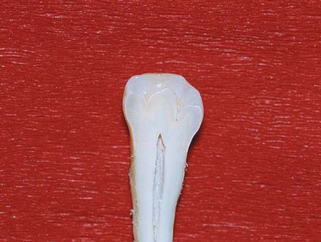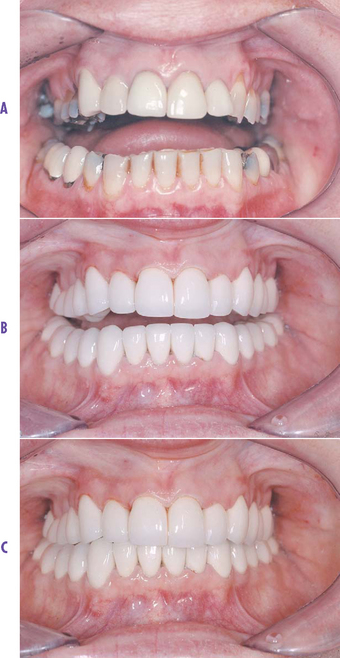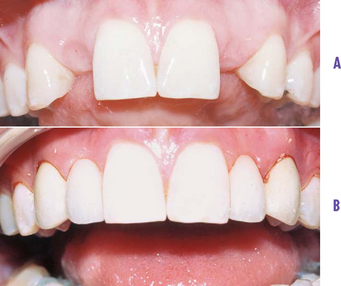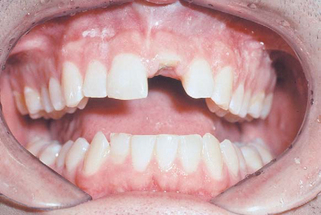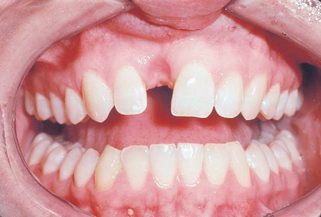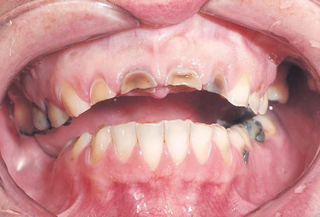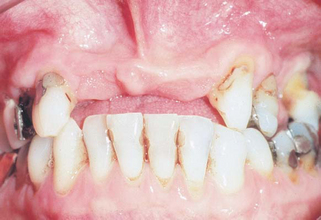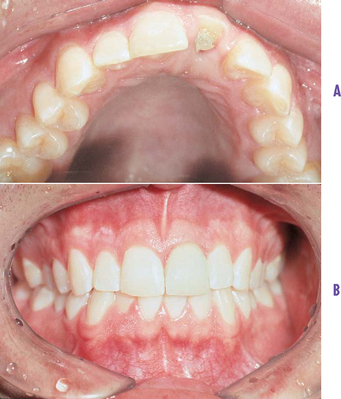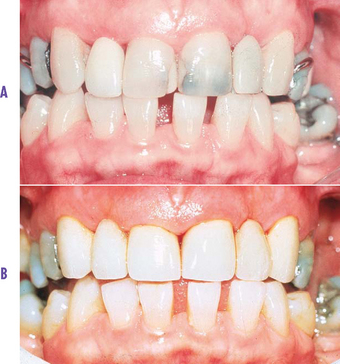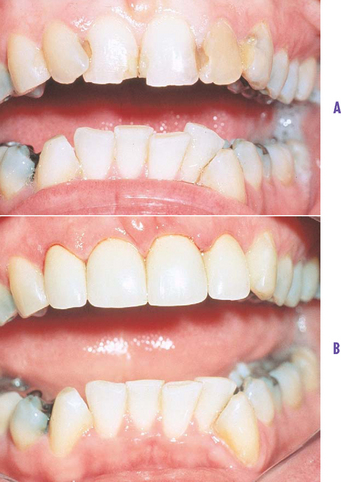CHAPTER 16 Prosthodontics, Fixed
Crowns (Caps) or Bridges Cemented Onto Teeth
Most of the tooth structure that is observable when looking into the mouth is dental enamel. It is a coating about 1/16 inch (1 to 1.5 mm) thick that covers the internal portion of the tooth, the dentin (FIG. 16.1). Enamel is the hardest substance in the body, and it protects the tooth from injury. Enamel is not present on the tooth root (the portion of the tooth that is in the bone). The portion of the tooth that protrudes into the mouth is called the clinical crown.
When a large portion of the enamel covering the clinical crown has been destroyed by dental caries (decay), has had fillings, is broken or worn, or is defective in other ways, the enamel layer must be replaced with an artificial crown (cap). Artificial crowns (caps) fit onto prepared (trimmed) teeth like a stocking cap fits on your head. Crowns (caps) are cemented into place, replacing the enamel and some of the dentin (FIG. 16.2).
If a single tooth or a few teeth are missing, the enamel may be removed from teeth adjacent to the space, and a fixed prosthesis (fixed bridge) may be cemented into place to fill the space created by the tooth removal (FIG. 16.3).
WHAT YOU SEE OR FEEL
Conditions, Signs, or Symptoms Related to Fixed Prosthodontics
1. One Missing Tooth
(FIG. 16.4). If one tooth is missing in the front of the mouth, the situation is unsightly, and most persons prefer to have the space filled with an artificial tooth as soon as possible. A missing tooth in the back portion of the mouth, in a location where it is not observable, may or may not require replacement because of appearance. However, most teeth that are removed, regardless of where they were located in the mouth, can cause significant movement of surrounding teeth and collapse of the occlusion (bite) (FIG. 16.5). If your missing tooth has caused an unsightly space in your smile, you may want to replace it soon; but if one of your back teeth was removed, you should discuss the potential collapse of the bite with your dentist before choosing from your alternatives. Usually, you have the following treatment alternatives:
2. A Few Missing Teeth
(FIG. 16.6). A few missing teeth usually cause an unsightly appearance and some loss of function. Almost always, the removal of a few teeth causes a collapse of the occlusion (bite) over a period of months to years (FIG. 16.7). Often the loss of a few teeth has been caused by trauma or ongoing periodontal (gum) disease, in which case periodontal therapy must be accomplished before fixed prostheses are placed. When a few teeth have been missing for months to years, significant soft-tissue and bone shrinkage usually have occurred. All of the conditions described infiuence the desirability or acceptability of the following treatment alternatives:
3. Many Missing Teeth
(FIG. 16.8). Almost always, many missing teeth cause an unsightly appearance, moderate loss of function, and eventual collapse of the occlusion (bite). Periodontal disease may have caused the loss of teeth and may need treatment before a fixed prosthesis is placed. Significant soft-tissue and bone shrinkage can be present also. All of the above conditions infiuence the acceptability of the following treatment alternatives:
4. Broken or Cracked Tooth (Teeth)
(FIG. 16.9). When a significant amount of tooth structure has broken off, a crown (cap) is usually the strongest and most esthetic in appearance for restoration of the tooth. However, several treatment alternatives are also possible:
5. Teeth With Large Dental Caries (Decayed Areas)
(FIG. 16.10). Significant destruction of tooth structure by dental caries is usually repaired best by placing a crown (cap), but more conservative measures may be possible also:
6. Teeth With Large Defective Fillings
(FIG. 16.11). Placement of large fillings in teeth usually requires removal of a significant portion of tooth structure, and replacement with new fillings is often not possible. Crowns (caps) are usually the strongest and most esthetically acceptable of the following alternatives:
Stay updated, free dental videos. Join our Telegram channel

VIDEdental - Online dental courses


